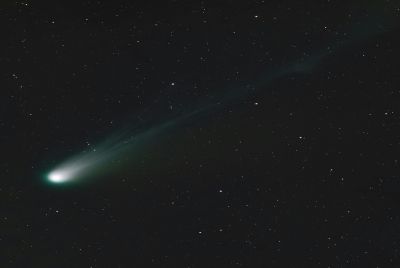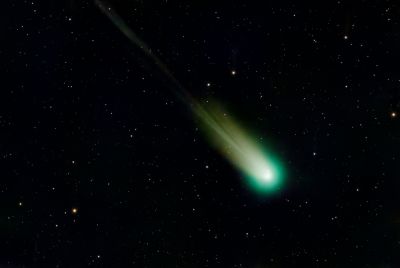3I/ATLAS Comet's Tail 'Burned Away' by Sun as Scientists Probe 'Tailless' Return
The interstellar comet 3I/Atlas has reappeared after its close solar pass, but its signature tail is gone.

Imagine a silent, unexpected visitor from the black abyss of deep space, a cosmic nomad that has travelled unimaginable distances between star systems. Now imagine that visitor, a comet, passing through the blistering heat of our Sun only to reappear dramatically changed, its brilliant, signature tail inexplicably gone.
That's precisely the mystery surrounding comet 3I/ATLAS, a rare interstellar object that has recently become visible again in our skies. For several weeks, it was hidden behind the sheer glare of the Sun, leading many astronomers to fear the worst.
Its recent re-emergence, however, is a victory, though a baffling one. The celestial body is missing its bright, glowing trail, an absent feature that has captured the attention of the scientific community and sparked a flurry of theories about its tumultuous encounter with our star.
3I/ATLAS: An Unprecedented Interstellar Wanderer
Comet 3I/ATLAS is no ordinary denizen of our neighbourhood; it's a rare interstellar visitor originating from outside our Solar System. Its status as an interstellar comet is why it's so important to study. It is only the third such object ever confirmed, following 'Oumuamua in 2017 and 2I/Borisov in 2019. This exclusivity makes every piece of information about it invaluable.
When scientists first detected 3I/ATLAS earlier this year, they quickly realised something was fundamentally different. Its orbital velocity was simply too high to be gravitationally bound to our Sun.
This speed confirmed its trajectory: it was a passer-through, originating from an entirely different stellar system and destined to continue its endless journey back into the icy void of deep space. Understanding its composition could provide a crucial, tangible sample of planet-forming material from a star system light-years away.
What Happened to 3I/ATLAS During Its Close Solar Approach?
In late October, 3I/Atlas disappeared from view as it reached perihelion—the point of its closest approach to the Sun. At this extreme proximity, the Sun's overwhelming light made any observation from Earth-based telescopes impossible.
The strong radiation and intense heat at perihelion posed a significant risk. Historically, many comets—even large, robust ones—do not survive such a close encounter with the Sun's plasma and heat, often fracturing or entirely vaporising.
When the comet finally moved far enough from the Sun to be observed again, astronomers were quick to notice the dramatic transformation: its tail was missing. A comet's tail, or coma, is typically formed when the Sun's heat causes surface ice and dust to vaporise, creating a bright, glowing trail behind the nucleus.
Experts have presented a few compelling hypotheses to explain the vanished tail of 3I/Atlas. The most direct explanation is that the ice and gas composing the tail simply burned away during its close, fiery pass by the Sun. The immense solar heat would have rapidly boiled off the volatile material.
Another possibility centres on the powerful forces of the solar wind—the stream of charged particles constantly flowing out from the Sun—which could have literally blown the tail away.
Some scientists also suggest that the tail might still exist but is currently facing away from Earth, making it difficult, if not impossible, for us to observe from our current vantage point.
Interestingly, when 3I/ATLAS was first approaching the Sun, ultraviolet (UV) rays began to break down large hydrocarbon molecules—compounds made of carbon and hydrogen—in the comet's atmosphere. This process generates a gas called diatomic carbon (C2), which is responsible for the distinct, faint greenish glow seen in many comets.
The physical reality of this interaction was explained quite succinctly by one scientist. 'It's similar to how our skin gets sunburned by UV rays,' said Zhang, 'The UV light breaks apart molecular bonds—in this case, within the comet's gases.'
This chemical reaction confirms how solar activity can drastically change a comet's appearance, impacting its colour, brightness, and even its visible structure as it traverses space.
Now that 3I/ATLAS is visible once more, researchers are intently studying it using telescopes both on the ground and in orbit. They are keen to determine its precise composition and, crucially, how its nucleus survived the Sun's heat without shattering.
Its existence and journey offer a rare, unrepeatable chance to gather data that could significantly advance our understanding of how planets and stars form in star systems far beyond our own.
Even without its spectacular tail, 3I/ATLAS remains a profoundly important discovery, offering scientists another precious opportunity to unlock the secrets of objects that travel to us from distant stars.
Astronomers will continue to track its progress as it gradually moves away from the Sun, resuming its solitary, long journey through the cosmos.
That interstellar visitor, 3I/ATLAS, remains a subject of intense scientific fascination. The mystery of its vanishing tail and its status as a messenger from a distant star system make it one of the most significant astronomical discoveries of our time.
As this remarkable object continues its long, one-way journey back into the vastness of deep space, every new observation brings us closer to understanding the origin of materials formed around other stars.
© Copyright IBTimes 2025. All rights reserved.




















